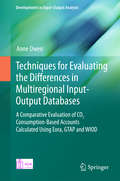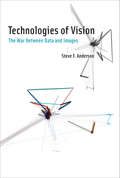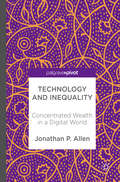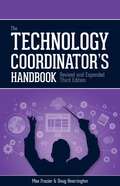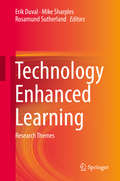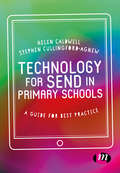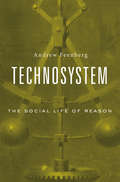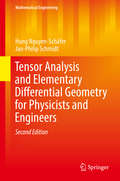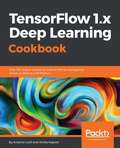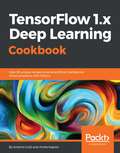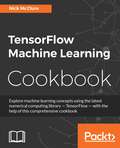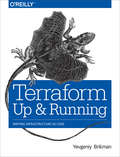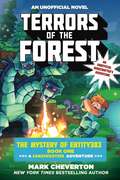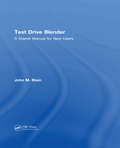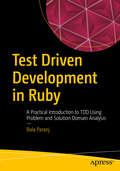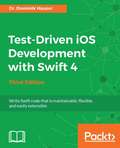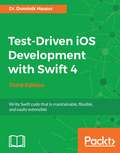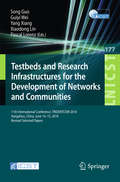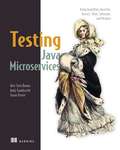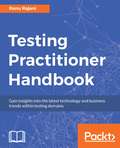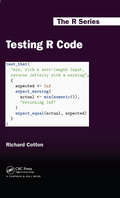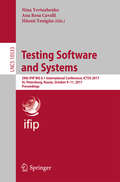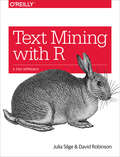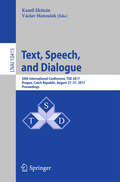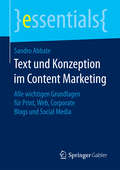- Table View
- List View
Techniques for Evaluating the Differences in Multiregional Input-Output Databases
by Anne OwenThis book introduces the Eora, Global Trade Analysis Project (GTAP) and World Input-Output (WIOD) databases and provides detailed metadata on the data sources, database structures and construction techniques used to build each system. It offers a detailed account of how multi-regional input-output (MRIO) databases are used to calculate consumption-based accounts - guiding the reader through each mathematical step and explaining the associated equations. It demonstrates that different MRIO databases calculate different national level consumption-based CO2 accounts. If these results are to be used as evidence in climate policy-making, analysts need to be confident about the accuracy of the databases and understand why the results differ. It carefully explains the mathematical equations behind each technique and provides a link to a repository where the reader can access specially prepared MATLAB functions associated with the techniques. To make meaningful comparisons between the three MRIO databases, each is mapped to a consistent classification system comprising 40 countries and 17 sectors. Further, readers can access the aggregated databases using the link provided. The effect of this aggregation is shown to be minimal, so readers can be confident that the aggregated versions of each database reflect the full-sized versions. The book concludes by making recommendations as to how future MRIO databases could be accurately and consistently constructed and how they should be used in policy-making in light of the findings.
Technologies of Vision: The War Between Data and Images (The\mit Press Ser.)
by Steve F AndersonAn investigation of the computational turn in visual culture, centered on the entangled politics and pleasures of data and images.If the twentieth century was tyrannized by images, then the twenty-first is ruled by data. In Technologies of Vision, Steve Anderson argues that visual culture and the methods developed to study it have much to teach us about today's digital culture; but first we must examine the historically entangled relationship between data and images. Anderson starts from the supposition that there is no great divide separating pre- and post-digital culture. Rather than creating an insular field of new and inaccessible discourse, he argues, it is more productive to imagine that studying “the digital” is coextensive with critical models—especially the politics of seeing and knowing—developed for understanding “the visual.”Anderson's investigation takes on an eclectic array of examples ranging from virtual reality, culture analytics, and software art to technologies for computer vision, face recognition, and photogrammetry. Mixing media archaeology with software studies, Anderson mines the history of technology for insight into both the politics of data and the pleasures of algorithms. He proposes a taxonomy of modes that describe the functional relationship between data and images in the domains of space, surveillance and data visualization. At stake in all three are tensions between the totalizing logic of data and the unruly chaos of images.
Technology and Inequality
by Jonathan P. AllenThis book will summarize what we know about technology and inequality across disciplines, and seek out new ways to analyze this relationship based on technology and business practices, with the objective of restoring digital technology as an engine of opportunity. Besides the unique focus on the role of technology in inequality, the book will have a unifying theme of tracing wealth creation and wealth capture in the technology sector, and relating specific practices--what technology companies actually do--to larger shifts in wealth and power. A clear conceptual framework will be used to analyze key industry case studies: search engines, social media, and the 'sharing' economy.
Technology Coordinator's Handbook, 3rd Edition
by Max Frasier Doug HearringtonThis handbook is designed to help technology coordinators become more effective learners and leaders so they can better assist students, teachers and administrators in the use of tech devices and resources. The technology coordinator can be seen as the orchestrator in the school or district, able to balance technology policies and procedures with device-specific requirements, locate funding and support, and facilitate ongoing training and support. In a time when technology is constantly changing, the technology coordinator adapts and stays abreast of the latest developments.This handbook is designed to help technology coordinators become more effective learners and leaders so they can better assist students, teachers and administrators in the use of tech devices and resources. The technology coordinator can be seen as the orchestrator in the school or district, able to balance technology policies and procedures with device-specific requirements, locate funding and support, and facilitate ongoing training and support. In a time when technology is constantly changing, the technology coordinator adapts and stays abreast of the latest developments. In this new edition of the highly respected Technology Coordinator’s Handbook, Max Frazier and co-author Doug Hearrington expand the scope of this practical guide to include New processes for technical support and technology lifecycle management. Considerations for BYOD programs. Practical advice on the implementation of cloud computing services. Profiles and job descriptions of technology coordinators and district leaders. Readers of this book — whether they are technology coordinators, teacher educators or administrators — will come away with a 360-degree view of the technology coordinator’s role and a new appreciation for teaching and learning with technology.
Technology Enhanced Learning
by Erik Duval Mike Sharples Rosamund SutherlandThis book provides an overview of the state-of-the-art in Technology Enhanced Learning (TEL). It is organized as a collection of 21 clusters or research themes, each introduced by leading experts and including references to the most relevant literature on the theme of each cluster. Additionally, four seminal papers on each theme are included with expert commentaries and updates. This volume is of high value to the TEL community, a large and active group of multidisciplinary researchers, to contextualize the field and define it as a distinct research area.
Technology for SEND in Primary Schools: A guide for best practice
by Ms Helen Caldwell Steve Cullingford-AgnewWith so many new education technologies being developed and made available to schools, how do teachers ensure they select resources that enhance inclusive teaching in the classroom? How can you make sure new technologies are integrated into every day teaching? This new text supports trainee and beginning teachers to harness the power of technology to make their classrooms truly inclusive. It helps you make informed selections of new technology and resources and make them work for everyone in your classroom. Along with clear guidance on how to implement an inclusive approach to the use of technology across a broad range of needs and curriculum themes, linking practical examples with discussion of pedagogical considerations this practical book: focuses on cutting edge technologies supports teachers to develop the knowledge and skills they need offers advice on how to assess individual learning and communication needs develops an understanding of the pedagogy needed to embed inclusive technology within whole class teaching
Technosystem: The Social Life of Reason
by Andrew FeenbergWe live in a world of technical systems designed in accordance with technical disciplines and operated by technically trained personnel—a unique social organization that largely determines our way of life. Andrew Feenberg’s theory of social rationality represents both the threats of technocratic modernity and the potential for democratic change.
Tensor Analysis and Elementary Differential Geometry for Physicists and Engineers (Mathematical Engineering #21)
by Hung Nguyen-Schäfer Jan-Philip SchmidtThis book presents tensors and differential geometry in a comprehensive and approachable manner, providing a bridge from the place where physics and engineering mathematics end, and the place where tensor analysis begins. Among the topics examined are tensor analysis, elementary differential geometry of moving surfaces, and k-differential forms. The book includes numerous examples with solutions and concrete calculations, which guide readers through these complex topics step by step. Mindful of the practical needs of engineers and physicists, book favors simplicity over a more rigorous, formal approach. The book shows readers how to work with tensors and differential geometry and how to apply them to modeling the physical and engineering world.The authors provide chapter-length treatment of topics at the intersection of advanced mathematics, and physics and engineering: • General Basis and Bra-Ket Notation• Tensor Analysis• Elementary Differential Geometry• Differential Forms• Applications of Tensors and Differential Geometry• Tensors and Bra-Ket Notation in Quantum MechanicsThe text reviews methods and applications in computational fluid dynamics; continuum mechanics; electrodynamics in special relativity; cosmology in the Minkowski four-dimensional space time; and relativistic and non-relativistic quantum mechanics.Tensor Analysis and Elementary Differential Geometry for Physicists and Engineers benefits research scientists and practicing engineers in a variety of fields, who use tensor analysis and differential geometry in the context of applied physics, and electrical and mechanical engineering. It will also interest graduate students in applied physics and engineering.
TensorFlow 1.x Deep Learning Cookbook
by Antonio GulliIn this book, you will learn how to efficiently use TensorFlow, Google's open source framework for deep learning. You will implement different deep learning networks such as Convolutional Neural Networks (CNNs), Recurrent Neural Networks (RNNs), Deep Q-learning Networks (DQNs), and Generative Adversarial Networks (GANs) with easy to follow independent recipes.
TensorFlow 1.x Deep Learning Cookbook
by Antonio Gulli Amita KapoorTake the next step in implementing various common and not-so-common neural networks with Tensorflow 1.x About This Book • Skill up and implement tricky neural networks using Google's TensorFlow 1.x • An easy-to-follow guide that lets you explore reinforcement learning, GANs, autoencoders, multilayer perceptrons and more. • Hands-on recipes to work with Tensorflow on desktop, mobile, and cloud environment Who This Book Is For This book is intended for data analysts, data scientists, machine learning practitioners and deep learning enthusiasts who want to perform deep learning tasks on a regular basis and are looking for a handy guide they can refer to. People who are slightly familiar with neural networks, and now want to gain expertise in working with different types of neural networks and datasets, will find this book quite useful. What You Will Learn • Install TensorFlow and use it for CPU and GPU operations • Implement DNNs and apply them to solve different AI-driven problems. • Leverage different data sets such as MNIST, CIFAR-10, and Youtube8m with TensorFlow and learn how to access and use them in your code. • Use TensorBoard to understand neural network architectures, optimize the learning process, and peek inside the neural network black box. • Use different regression techniques for prediction and classification problems • Build single and multilayer perceptrons in TensorFlow • Implement CNN and RNN in TensorFlow, and use it to solve real-world use cases. • Learn how restricted Boltzmann Machines can be used to recommend movies. • Understand the implementation of Autoencoders and deep belief networks, and use them for emotion detection. • Master the different reinforcement learning methods to implement game playing agents. • GANs and their implementation using TensorFlow. In Detail Deep neural networks (DNNs) have achieved a lot of success in the field of computer vision, speech recognition, and natural language processing. The entire world is filled with excitement about how deep networks are revolutionizing artificial intelligence. This exciting recipe-based guide will take you from the realm of DNN theory to implementing them practically to solve the real-life problems in artificial intelligence domain. In this book, you will learn how to efficiently use TensorFlow, Google's open source framework for deep learning. You will implement different deep learning networks such as Convolutional Neural Networks (CNNs), Recurrent Neural Networks (RNNs), Deep Q-learning Networks (DQNs), and Generative Adversarial Networks (GANs) with easy to follow independent recipes. You will learn how to make Keras as backend with TensorFlow. With a problem-solution approach, you will understand how to implement different deep neural architectures to carry out complex tasks at work. You will learn the performance of different DNNs on some popularly used data sets such as MNIST, CIFAR-10, Youtube8m, and more. You will not only learn about the different mobile and embedded platforms supported by TensorFlow but also how to set up cloud platforms for deep learning applications. Get a sneak peek of TPU architecture and how they will affect DNN future. By using crisp, no-nonsense recipes, you will become an expert in implementing deep learning techniques in growing real-world applications and research areas such as reinforcement learning, GANs, autoencoders and more. Style and approach This book consists of hands-on recipes where you'll deal with real-world problems. You'll execute a series of tasks as you walk through data mining challenges using TensorFlow 1.x. Your one-stop solution for common and not-so-common pain points, this is a book that you must have on the shelf.
TensorFlow Machine Learning Cookbook
by Nick McclureExplore machine learning concepts using the latest numerical computing library — TensorFlow — with the help of this comprehensive cookbook About This Book • Your quick guide to implementing TensorFlow in your day-to-day machine learning activities • Learn advanced techniques that bring more accuracy and speed to machine learning • Upgrade your knowledge to the second generation of machine learning with this guide on TensorFlow Who This Book Is For This book is ideal for data scientists who are familiar with C++ or Python and perform machine learning activities on a day-to-day basis. Intermediate and advanced machine learning implementers who need a quick guide they can easily navigate will find it useful. What You Will Learn • Become familiar with the basics of the TensorFlow machine learning library • Get to know Linear Regression techniques with TensorFlow • Learn SVMs with hands-on recipes • Implement neural networks and improve predictions • Apply NLP and sentiment analysis to your data • Master CNN and RNN through practical recipes • Take TensorFlow into production In Detail TensorFlow is an open source software library for Machine Intelligence. The independent recipes in this book will teach you how to use TensorFlow for complex data computations and will let you dig deeper and gain more insights into your data than ever before. You'll work through recipes on training models, model evaluation, sentiment analysis, regression analysis, clustering analysis, artificial neural networks, and deep learning – each using Google's machine learning library TensorFlow. This guide starts with the fundamentals of the TensorFlow library which includes variables, matrices, and various data sources. Moving ahead, you will get hands-on experience with Linear Regression techniques with TensorFlow. The next chapters cover important high-level concepts such as neural networks, CNN, RNN, and NLP. Once you are familiar and comfortable with the TensorFlow ecosystem, the last chapter will show you how to take it to production. Style and approach This book takes a recipe-based approach where every topic is explicated with the help of a real-world example.
Terraform: Writing Infrastructure as Code
by Yevgeniy BrikmanTerraform has emerged as a key player in the DevOps world for defining, launching, and managing infrastructure as code (IAC) across a variety of cloud and virtualization platforms, including AWS, Google Cloud, and Azure. This hands-on book is the fastest way to get up and running with Terraform.Gruntwork co-founder Yevgeniy (Jim) Brikman walks you through dozens of code examples that demonstrate how to use Terraform’s simple, declarative programming language to deploy and manage infrastructure with just a few commands. Whether you’re a novice developer, aspiring DevOps engineer, or veteran sysadmin, this book will take you from Terraform basics to running a full tech stack capable of supporting a massive amount of traffic and a large team of developers.Compare Terraform to other IAC tools, such as Chef, Puppet, Ansible, and Salt StackUse Terraform to deploy server clusters, load balancers, and databasesLearn how Terraform manages the state of your infrastructure and how it impacts file layout, isolation, and lockingCreate reusable infrastructure with Terraform modulesTry out advanced Terraform syntax to implement loops, if-statements, and zero-downtime deploymentUse Terraform as a team, including best practices for writing, testing, and versioning Terraform code
Terrors of the Forest: The Mystery of Entity303 Book One: A Gameknight999 Adventure: An Unofficial Minecrafter?s Adventure (Gameknight999 Series #1)
by Mark ChevertonGameknight999 reenters Minecraft to find it completely changed. There are new monsters that he’s never seen before: giants and skeleton druids and pinch beetles and king spiders and mistwolves. Villages are larger than ever, and more heavily fortified; Minecraft had become much more dangerous. Even the very trees had changed, with some of them reaching up taller than the User-that-is-not-a-user ever thought was imaginable.There’s a diamond block portal outside of Crafter’s village, and rumors are spreading that a strange user was seen coming out of the portal with a young boy, before they disappeared into another portal, leaving behind a square hole one block deep with a ring of flowers around it. Gameknight recognizes it as the portal to reach the Twilight Forest mod. But how can there be mods here in the vanilla Minecraft?The User-that-is-not-a-user follows the trail, and finds odd mentions of "303” and "White Castle.” But what do the clues mean? Just how dangerous is this new user to Minecraft, and where is he taking the young NPC? Only Gameknight999 will be able to find out.Sky Pony Press, with our Good Books, Racehorse and Arcade imprints, is proud to publish a broad range of books for young readers-picture books for small children, chapter books, books for middle grade readers, and novels for young adults. Our list includes bestsellers for children who love to play Minecraft; stories told with LEGO bricks; books that teach lessons about tolerance, patience, and the environment, and much more. While not every title we publish becomes a New York Times bestseller or a national bestseller, we are committed to books on subjects that are sometimes overlooked and to authors whose work might not otherwise find a home.
Test Drive Blender: A Starter Manual for New Users
by John M. BlainThis book will introduce you to the controls and steer you towards understanding what Blender can do. With this program you can create 3D models of objects and characters. The objects and characters can be placed in scenes. The scenes are captured by camera and rendered into digital images. The objects and characters can be animated and then, again, captured by camera and rendered to video files. Video files can then be compiled into movies. This book will show you how to make the Blender program go through some of its paces and give you an insight into this fantastic world. You will be shown the controls and given operation instructions allowing you to activate a variety of features.
Test Driven Development in Ruby
by Bala ParanjLearn the basics of test driven development (TDD) using Ruby. You will carry out problem domain analysis, solution domain analysis, designing test cases, and writing tests first. These fundamental concepts will give you a solid TDD foundation to build upon. Test Driven Development in Ruby is written by a developer for developers. The concepts are first explained, then a coding demo illustrates how to apply the theory in practice. At the end of each chapter an exercise is given to reinforce the material. Complete with working files and code samples, you'll be able to work alongside the author, a trainer, by following the material in this book. What You Will Learn Carry out problem domain analysis, solution domain analysis, designing test cases, and writing tests first Use assertions Discover the structure of a test and the TDD cycle Gain an understanding of minimal implementation, starter test, story test, and next test Handle refactoring using Ruby Hide implementation details Test precisely and concretely Make your code robust Who This Book Is For Experienced Ruby programmers or web developers with some prior experience with Ruby.
Test-Driven iOS Development with Swift 4
by Dominik HauserUse test-driven approach to develop highly-functional iOS apps with Swift 4 and Xcode 9 About This Book A practical guide to writing effective, organized, and clean code that works well Learn test-driven principles to help you build better-designed apps with fewer bugs A comprehensive overview of the techniques available for TDD in Swift Who This Book Is For To get the most out of this book, you will need some prior experience with Swift application development. You may have already heard about Test-Driven Development (TDD) but you don't need any prior experience of applying it to Swift applications. What You Will Learn Implement TDD in Swift application development Find bugs before you enter code using the TDD approach Use TDD to build models, view controllers, and views Test network code with asynchronous tests and stubs Write code that is a joy to read and maintain Develop functional tests to ensure the app works as planned In Detail Test-driven development (TDD) is a proven way to find software bugs early. Writing tests before you code improves the structure and maintainability of your apps. Using TDD, in combination with Swift 4's improved syntax, means there is no longer any excuse for writing bad code. This book will help you understand the process of TDD and how to apply it to your apps written in Swift. Through practical, real-world examples, you'll learn how to implement TDD in context. You will begin with an overview of the TDD workflow and then delve into unit-testing concepts and code cycles. You will also plan and structure your test-driven iOS app, and write tests to drive the development of view controllers and helper classes. Next, you'll learn how to write tests for network code and explore how the test-driven approach—in combination with stubs—helps you write network code even before the backend component is finished. Finally, the book will guide you through the next steps to becoming a testing expert by discussing integration tests, Behavior Driven Development (BDD), open source testing frameworks, and UI Tests (introduced in Xcode 9). Style and approach Using a step-by-step approach, you will develop an entire iOS app using TDD. During the course of the book, you will explore different strategies for writing tests for models, View Controllers, and networking code.
Test-Driven iOS Development with Swift 4 - Third Edition
by Dr Dominik HauserUse test-driven approach to develop highly-functional iOS apps with Swift 4 and Xcode 9 About This Book • A practical guide to writing effective, organized, and clean code that works well • Learn test-driven principles to help you build better-designed apps with fewer bugs • A comprehensive overview of the techniques available for TDD in Swift Who This Book Is For To get the most out of this book, you will need some prior experience with Swift application development. You may have already heard about Test-Driven Development (TDD) but you don't need any prior experience of applying it to Swift applications. What You Will Learn • Implement TDD in Swift application development • Find bugs before you enter code using the TDD approach • Use TDD to build models, view controllers, and views • Test network code with asynchronous tests and stubs • Write code that is a joy to read and maintain • Develop functional tests to ensure the app works as planned In Detail Test-driven development (TDD) is a proven way to find software bugs early. Writing tests before you code improves the structure and maintainability of your apps. Using TDD, in combination with Swift 4's improved syntax, means there is no longer any excuse for writing bad code. This book will help you understand the process of TDD and how to apply it to your apps written in Swift. Through practical, real-world examples, you'll learn how to implement TDD in context. You will begin with an overview of the TDD workflow and then delve into unit-testing concepts and code cycles. You will also plan and structure your test-driven iOS app, and write tests to drive the development of view controllers and helper classes. Next, you'll learn how to write tests for network code and explore how the test-driven approach—in combination with stubs—helps you write network code even before the backend component is finished. Finally, the book will guide you through the next steps to becoming a testing expert by discussing integration tests, Behavior Driven Development (BDD), open source testing frameworks, and UI Tests (introduced in Xcode 9). Style and approach Using a step-by-step approach, you will develop an entire iOS app using TDD. During the course of the book, you will explore different strategies for writing tests for models, View Controllers, and networking code.
Testbeds and Research Infrastructures for the Development of Networks and Communities
by Song Guo Guiyi Wei Yang Xiang Xiaodong Lin Pascal LorenzThis book constitutes the refereed proceedings of the 11th International Conference on Testbeds and Research Infrastructures for the Development of Networks and Communities, TridentCom 2016, held in Hangzhou, China, in June 2016. The 16 papers were carefully selected from 25 submissions and provide a forum about technologies of big data, cyber physical systems and computer communications. The papers consist of 4 sessions covering future Internet and software defined network, network testbed design and implementation, testbed for network applications, and QoS/QoE on networks.
Testing Java Microservices: Using Arquillian, Hoverfly, AssertJ, JUnit, Selenium, and Mockito
by Jason Porter Alex Soto Andrew GumbrechtSummaryTesting Java Microservices teaches you to implement unit and integration tests for microservice systems running on the JVM. You'll work with a microservice environment built using Java EE, WildFly Swarm, and Docker. You'll learn how to increase your test coverage and productivity, and gain confidence that your system will work as you expect.Purchase of the print book includes a free eBook in PDF, Kindle, and ePub formats from Manning Publications.About the TechnologyMicroservice applications present special testing challenges. Even simple services need to handle unpredictable loads, and distributed message-based designs pose unique security and performance concerns. These challenges increase when you throw in asynchronous communication and containers.About the BookTesting Java Microservices teaches you to implement unit and integration tests for microservice systems running on the JVM. You'll work with a microservice environment built using Java EE, WildFly Swarm, and Docker. You'll advance from writing simple unit tests for individual services to more-advanced practices like chaos or integration tests. As you move towards a continuous-delivery pipeline, you'll also master live system testing using technologies like the Arquillian, Wiremock, and Mockito frameworks, along with techniques like contract testing and over-the-wire service virtualization. Master these microservice-specific practices and tools and you'll greatly increase your test coverage and productivity, and gain confidence that your system will work as you expect.What's InsideTest automationIntegration testing microservice systemsTesting container-centric systemsService virtualizationAbout the ReaderWritten for Java developers familiar with Java EE, EE4J, Spring, or Spring Boot.About the AuthorsAlex Soto Bueno and Jason Porter are Arquillian team members. Andy Gumbrecht is an Apache TomEE developer and PMC. They all have extensive enterprise-testing experience.Table of ContentsAn introduction to microservicesApplication under testUnit-testing microservicesComponent-testing microservicesIntegration-testing microservicesContract testsEnd-to-end testingDocker and testingService virtualizationContinuous delivery in microservices
Testing Practitioner Handbook
by Renu RajaniGain insights into the latest technology and business trends within testing domains About This Book • This book covers the latest trends that every Testing and QA professional should keep up-to-date with given the advancements in digital technologies. • Master cutting-edge testing techniques for emerging areas such as IOT, Machine Learning, Cognitive. • Best practices for Testing and Quality Assurance within several industry domains. Who This Book Is For This book is targeted at those working in the QA and Testing areas. The book does not cover testing basics, which QA professional are already familiar with—for example, writing a test plan or test case, and so on. What You Will Learn • Understand the TCOE model, managed services, the structure of testing in Agile/DevOps engagements, factory models, and crowdsourcing • Implement testing processes, practices, and automation tools in the Agile/DevOps life cycle • Adapt to current technologies in social media, mobile, analytics and the Cloud • Leverage cognitive intelligence/machine-learning, robotics, and the Internet of Things in testing • How key industries/domains (consumer products and retail, energy and utilities, healthcare, telecom, and automotive) adapt to digital transformation • Future directions for the QA industry, consulting careers, testing profession, and professionals In Detail The book is based on the author`s experience in leading and transforming large test engagements and architecting solutions for customer testing requirements/bids/problem areas. It targets the testing practitioner population and provides them with a single go-to place to find perspectives, practices, trends, tools, and solutions to test applications as they face the evolving digital world. This book is divided into five parts where each part explores different aspects of testing in the real world. The first module explains the various testing engagement models. You will then learn how to efficiently test code in different life cycles. The book discusses the different aspects of Quality Analysis consideration while testing social media, mobile, analytics, and the Cloud. In the last module, you will learn about futuristic technologies to test software. By the end of the book, you will understand the latest business and IT trends in digital transformation and learn the best practices to adopt for business assurance. Style and approach This book is a compilation of the latest business and IT trends in digital transformation & Tools and Best Practices that QA professionals need to adopt for business assurance.
Testing R Code (Chapman & Hall/CRC The R Series)
by Richard CottonLearn how to write R code with fewer bugs. The problem with programming is that you are always one typo away from writing something silly. Likewise with data analysis, a small mistake in your model can lead to a big mistake in your results. Combining the two disciplines means that it is all too easy for a missed minus sign to generate a false prediction that you don’t spot until it’s too late. Testing is the only way to be sure that your code, and your results, are correct. Testing R Code teaches you how to perform development-time testing using the testthat package, allowing you to ensure that your code works as intended. The book also teaches run-time testing using the assertive package; enabling your users to correctly run your code. After beginning with an introduction to testing in R, the book explores more advanced cases such as integrating tests into R packages; testing code that accesses databases; testing C++ code with Rcpp; and testing graphics. Each topic is explained with real-world examples, and has accompanying exercises for readers to practise their skills — only a small amount of experience with R is needed to get started!
Testing Software and Systems
by Nina Yevtushenko Ana Rosa Cavalli Hüsnü YenigünThis book constitutes the refereed proceedings of the 29th IFIP WG 6. 1 International Conference on Testing Software and Systems ICTSS 2017, held in St. Petersburg, Russia, in October 2017. The 18 full papers and 4 short papers presented were carefully reviewed and selected from 41 submissions. The topics of the volume cover model based testing; test derivation and monitoring; fault localization and system testing including real time systems.
Text Mining with R: A Tidy Approach
by David Robinson Julia SilgeMuch of the data available today is unstructured and text-heavy, making it challenging for analysts to apply their usual data wrangling and visualization tools. With this practical book, you’ll explore text-mining techniques with tidytext, a package that authors Julia Silge and David Robinson developed using the tidy principles behind R packages like ggraph and dplyr. You’ll learn how tidytext and other tidy tools in R can make text analysis easier and more effective.The authors demonstrate how treating text as data frames enables you to manipulate, summarize, and visualize characteristics of text. You’ll also learn how to integrate natural language processing (NLP) into effective workflows. Practical code examples and data explorations will help you generate real insights from literature, news, and social media.Learn how to apply the tidy text format to NLPUse sentiment analysis to mine the emotional content of textIdentify a document’s most important terms with frequency measurementsExplore relationships and connections between words with the ggraph and widyr packagesConvert back and forth between R’s tidy and non-tidy text formatsUse topic modeling to classify document collections into natural groupsExamine case studies that compare Twitter archives, dig into NASA metadata, and analyze thousands of Usenet messages
Text, Speech, and Dialogue: 20th International Conference, TSD 2017, Prague, Czech Republic, August 27-31, 2017, Proceedings (Lecture Notes in Computer Science #10415)
by Kamil Ekštein and Václav MatoušekThis book constitutes the proceedings of the 20th International Conference on Text, Speech, and Dialogue, TSD 2017, held in Prague, CzechRepublic, in August 2017.The 56 regular papers presented together with 3 abstracts of keynote talks were carefully reviewed and selected from 117 submissions. They focus on topics such as corpora and language resources; speech recognition; tagging, classification and parsing of text and speech; speech and spoken language generation; semantic processing of text and speech; integrating applications of text and speech processing; automatic dialogue systems; as well as multimodal techniques and modelling.
Text und Konzeption im Content Marketing: Alle wichtigen Grundlagen für Print, Web, Corporate Blogs und Social Media (essentials)
by Sandro AbbateIn diesem essential erfahren Sie alle wichtigen Grundlagen der Text- und Konzeptentwicklung f#65533;r eine Content-Marketing-Strategie. Der Autor beschreibt die erfolgsentscheidenden Stellschrauben, die Sie beachten m#65533;ssen und in die Sie ausreichend Zeit investieren sollten: von der vorab zu leistenden Denkarbeit, #65533;ber die strukturierte Konzeptentwicklung, bis hin zur optimalen Textarbeit f#65533;r Webtexte. Abgerundet wird dieser Band durch Interviews mit renommierten Experten und Erfolgsbeispielen aus der Praxis.
